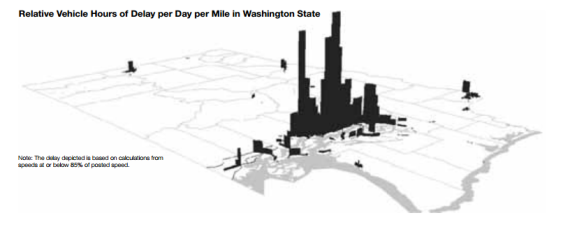Apparently, a handful of state legislators in Washington have introduced a bill to add “congestion relief” as one of the state transportation department’s official goals.
I’m not sure this is good policy. Peak-period congestion is just one of wide range of factors to consider when designing and operating a transportation system. If Olympia wants to add in congestion relief as an explicit policy goal, why not go broader, directing WSDOT to minimize all sorts of other transportation costs, from health to vehicle ownership to fuel costs to air pollution?
But while the idea lacks in policy smarts, it certainly has political appeal. Nobody likes sitting in traffic, and fighting congestion is a crowd pleaser.That’s why the bill has already attracted a number of supporters.
So it’ll be interesting to see how state legislators react once they learn what “congestion relief” will likely mean in practice, once it becomes a core part of WSDOT’s mission.
You see, WSDOT has been tracking and mapping congestion for years. And year after year, the agency has found that the state’s heaviest congestion is concentrated in and around Seattle. And that means that a focus on “congestion relief” could be a de facto instruction for WDOT to focus more of its attention on a relative handful of highways in and around the state’s largest city.
Take a look at this map of the state. It’s displayed from an odd angle, but it shows quite clearly where congestion is worst: right in the heart of Seattle. In fact, it looks like the epicenter is right downtown, with congestion radiating out from there.
Everett and Tacoma have a fair share of congested roadway too. But the congestion in other parts of the state—southeast Washington, the Tri-cities, Spokane—barely registers.
And it’s not just WSDOT who says that greater Seattle is the state’s congestion hotspot. Traffic analysis firm INRIX lists I-5 southbound from the Seattle city limits into downtown as the 11th most congested road segment in the country. Meanwhile, I-405 Southbound from SR-520 towards Bellevue ranks 27th, making it the only other road segment in the state to crack the top 75.
More generally, as the following chart shows, making congestion an official state priority can only mean one thing: WSDOT will have to focus a larger share of its resources on Puget Sound, diverting money and attention on transportation issues elsewhere in the state.
And here’s another thing. Some legislators who support the bill probably hope that a “congestion relief” policy would nudge WSDOT to build wider roads in their districts. But as it turns out, transportation researchers generally find that road widening is an expensive and often ineffective way to ease congestion. And WSDOT barely has the money to complete the projects it’s got on the books, let alone start new ones.
Meanwhile, WSDOT’s most recent congestion report shows what really fights congestion: tolls. As the state’s data shows, tolls turned SR-520 from one of the most congested roadways in the state to one that moves along quite nicely during rush hour. In fact, WSDOT’s most recent congestion report shows that total congestion delays on SR-520 fell by a massive 79 percent in two years.
So in short, if legislators add “congestion relief” as an explicit priority, that’s tantamount to telling the agency to…
A) Focus even more of its attention on the major highways in and around the city of Seattle, and
B) Move forward more aggressively with the only truly effective congestion-fighting tool the state has found: tolls.
And while I can’t speak for state legislators supporting this idea, I’d be very surprised if this is what they actually want. Several of them live outside the Puget Sound, and others live in largely suburban or semi- rural districts—places where congestion may feel like a nuisance, but where WSDOT data doesn’t show that it’s a major problem, at least for the roads that it manages. For many of these districts, telling WSDOT to focus on congestion will mean telling WSDOT to ignore their transportation needs. And at the same time, I’m certain that some of these legislators’ constituents will be surprised to find that their representatives are nudging WSDOT towards greater use of tolls.











Elaine Livengood
My first question is, what about the congestion on SOUTH I=405, going in both directions through Renton? That backed up, smoggy area is far worse than it was several years ago. I know firsthand, as I live near it’s fumy epicenter. Bus service out here in the Southend is crappy, too. Of course, Bellevue gets more service and far nicer bus rides.
Elaine Livengood
And as far as Tolls go, why not make them correspond to the vehicle’s miles driven? Those of us who only drive 1,000 miles or less per year should pay less than road hogs.